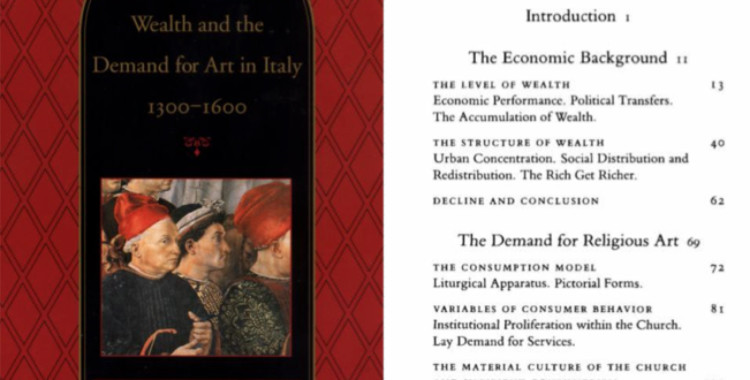
Resource Rewind: Wealth & the Demand for Art in Italy
August 27, 2015
by Diana Greenwald | Filed in: Resources
In honor of the back-to-school season, Arts & Econ is featuring a series of posts that highlight classic scholarly works about the economics of art. Each post will focus on one book. The first featured resource is Richard A. Goldthwaite’s Wealth and the Demand for Art in Italy, 1300 – 1600 (John Hopkins University Press, 1993). Goldthwaite—an emeritus professor of history at Johns Hopkins University—is an economic historian. An authority on the economy of Renaissance Italy, his later works focused on the interaction between the economics and the art of the Italian Peninsula. A powerful writer and visionary scholar, his 1993 study of demand for material culture voices and refines research questions and topics that are relevant for scholars interested in the economics of art across time and geography. Below, three passages from his book are featured with a brief discussion of why they continue to be relevant today.
Since Johann Joachim Winckelmann’s praise of the Belvedere Torso’s perfection, art has often been placed in a category above other goods. Its production and consumption supposedly do not conform to the normal laws of supply and demand. It is too beautiful, too perfect and too expensive. Goldthwaite’s work plays a role in revising this entrenched narrative. In economics, demand for all goods (except for Giffen goods) increases as budgets grow and/or as prices decline. Goods considered to be fine or decorative art also conform to these rules. Among the richest consumers, factors beyond price influence purchasing choices; however, it is rare for any consumer—even the wealthiest art collectors—to be price insensitive.
In addition to repositioning the consumption of art within the laws of supply and demand, Goldthwaite reminds readers of basic structural constraints to that consumption. The simple point that building more housing or churches creates both space and a need for more objects is a powerful one. There are not only budgetary but also physical constraints that mold art consumption. For a poignant example of this, watch the (admittedly hard to track down) film Botticelli’s Primavera: myths or fingerprints? (1996). In this documentary, filmmaker Agnieszka Piotrowska arranges for workers to carry a to-scale copy of Botticelli’s Primavera around Florence. It quickly becomes clear that several eminent art historians’ theories about where the painting was placed are wrong—simply because the painting could never physically fit in those places. Goldthwaite reminds us that simple structural explanations are sometimes banal, but are often important.
One of the most difficult problems historians face is disentangling correlation from causation. A socio-political change may occur around the same time as a change in artistic output, but it is difficult to say if the two changes are coincident of if the change in the society causes the change in art. A nuanced assertion like Goldthwaite’s—which argues that certain liturgical practices were a necessary but not sufficient condition for changes to religious artwork—provides a good example of how to negotiate questions about causation and art.
Consumption itself is a cultural phenomenon of which art is only one manifestation. The central task of this study is to view art in the larger context of the world of goods of which it is a part and to consider the demand for art as therefore subject to some of those forces that generate material culture by changing the quantity and nature of goods in general.” (‘Introduction’, p. 1)
“The more rich Italians spent for buildings, the more they found themselves spending for the furnishing of these places, both domestic and ecclesiastical; hence, their investment in architecture had a multiplier effect in the expansion of their world of goods.” (‘The Structure of Wealth’, p. 62)
“While the demand for pictures did not necessarily derive from the demand for the liturgical apparatus, the liturgical apparatus was necessarily the prior condition for that demand.” (‘The Demand for Religious Art’, p. 80)
It was, of course, difficult to choose just three passages from Wealth and the Demand for Art in Italy, 1300 – 1600. There were many more excerpts that could have also been included. On the whole, this relatively short book (280 pages) is certainly worth a read (or re-read).
Resource Rewind: The Embarrassment of Riches >>
<< Art History, Capital Investment & Post Industrial Society
